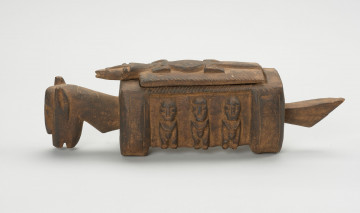
Door lock with key
między 1951 — 1996
National Museum in Szczecin
Part of the collection: Collection of Dogonian art
The door to the big ginna house (in the Dogo-so language ginna means big house, but also big family). Ginna is the seat of the family patriarch (ginna bana), who lives there together with his wives and children. It is also a temple honouring the ancestors of the founders of the family. The particular house is a two-storey structure. According to anthropologist Barbara DeMott, three different spaces can be distinguished in a ginna house. The ground floor is the living area occupied by ginna bana and his family. The first floor houses the family's granaries, while the terrace formed on the flat roof, surrounded by a small wall, is a ritual space. It is on this terrace that masked dances are held during the Dama festival. It is also here that the low rooms contain altars to honour the ancestors.The ginna bana's house is cuboid, dominating the other single-storey houses as it is about 1.5 metres higher than them. The interior is divided into several rooms devoid of windows. The most important of these is dembere occupied by the man. In it, there is an elevation formed from banco bricks, which serves ginna bana as a bed. A characteristic element of the large house is the façade with niches dedicated to the ancestors of the family. Their appearance was described as follows by Ogotemmeli Dolo: In the vertical two rows of five columns are ten fingers and when you look at the house from the front, you see two outstretched hands. The alcoves are ancestral dwellings, occupied by them in order of birth, starting from the top row. They should never be pawned off because ancestors need air to breathe. The entrance door is located in the middle of the façade, between two rows of vertical, narrow recesses called columns by Ogotemmeli.
Ewa Prądzyńska
Author / creator
Dimensions
cały obiekt: height: 111,5 cm, width: 56 cm
Object type
living space
Creation time / dating
Creation / finding place
Identification number
Location / status

między 1951 — 1996
National Museum in Szczecin
około 1970
National Museum in Szczecin

między 1951 — 2000
National Museum in Szczecin
DISCOVER this TOPIC
National Museum in Szczecin
DISCOVER this PATH
Educational path